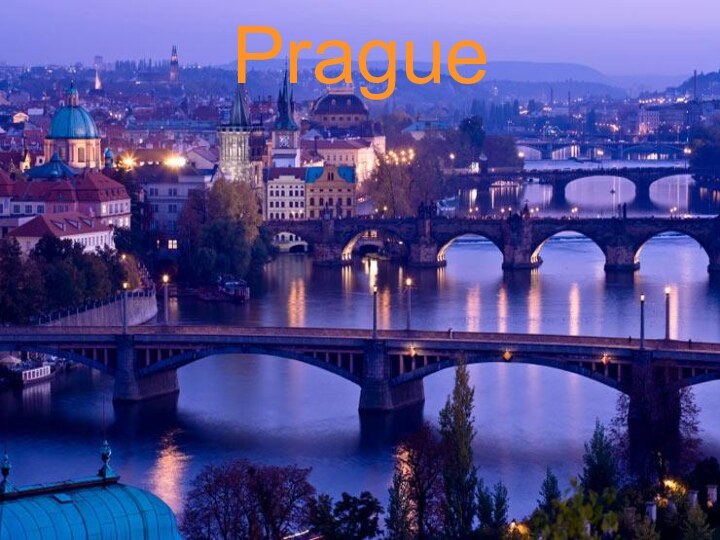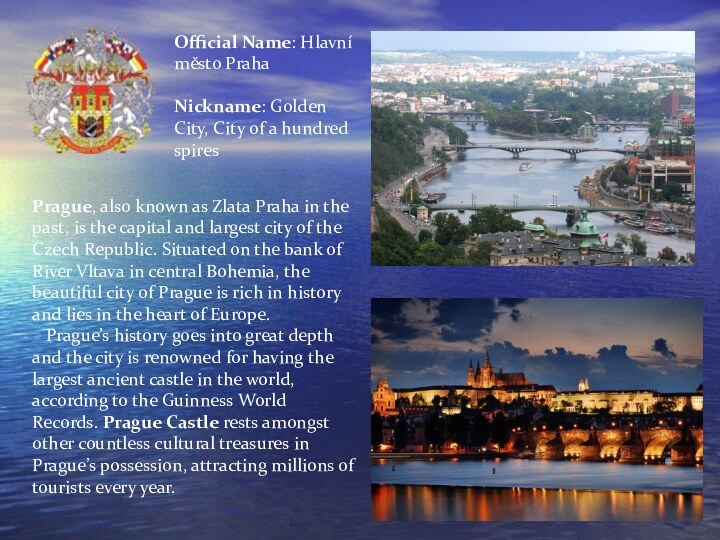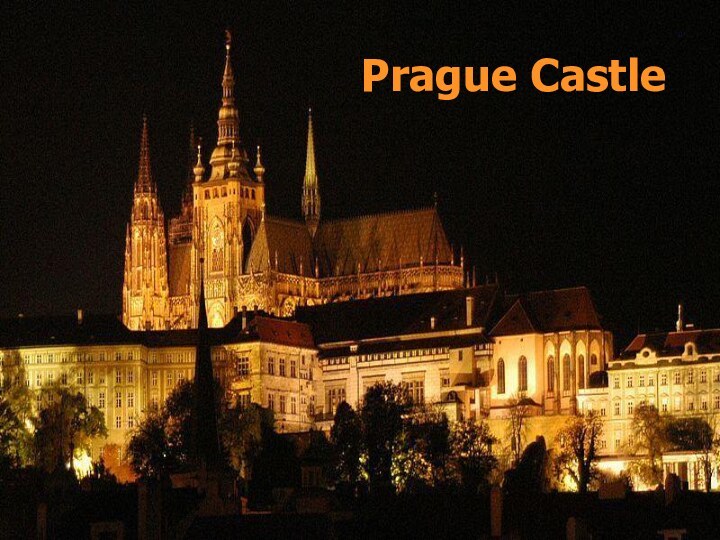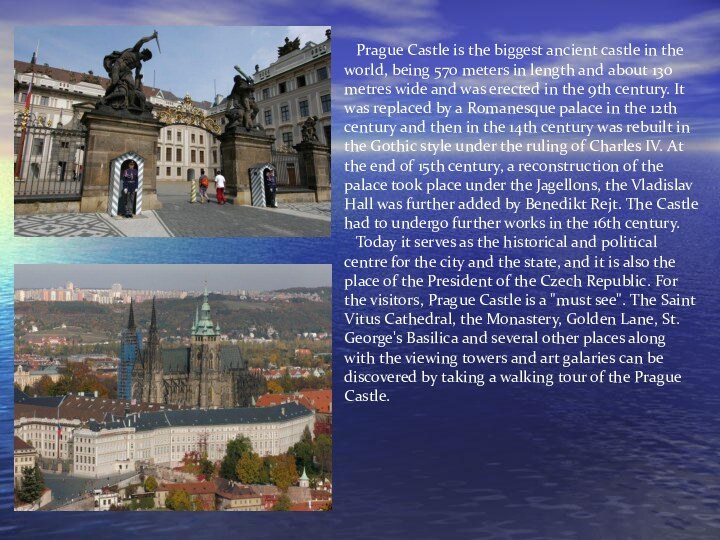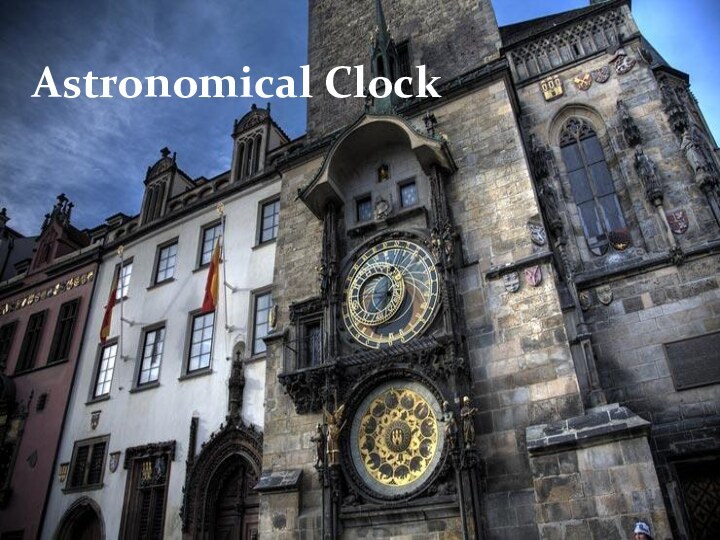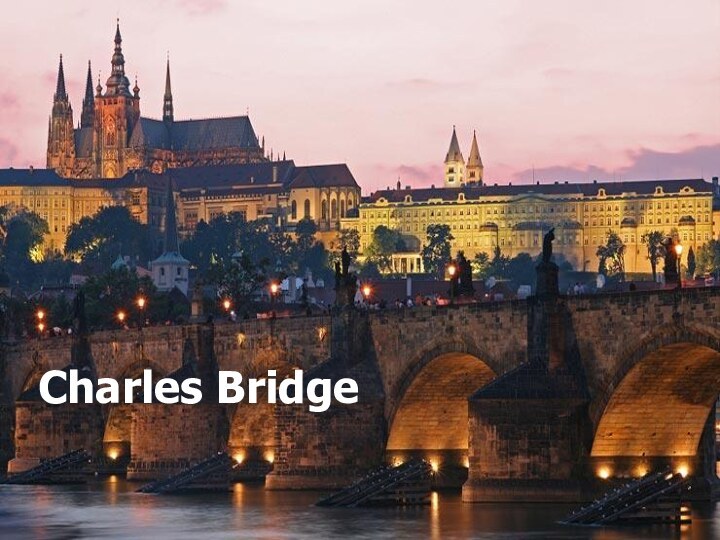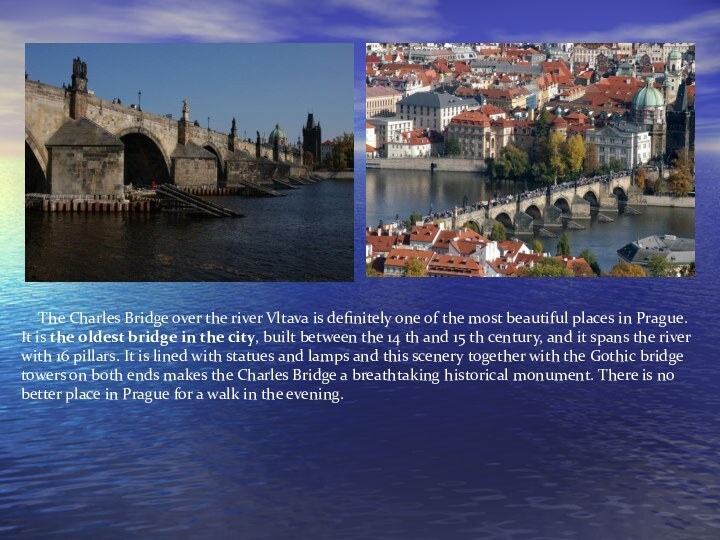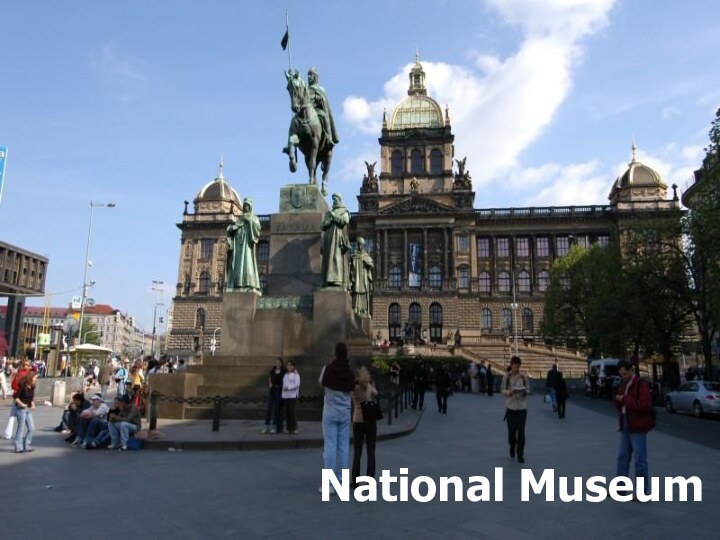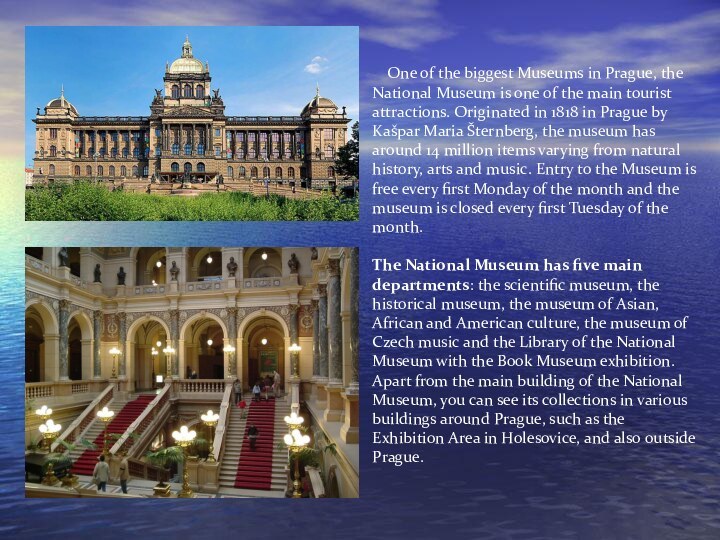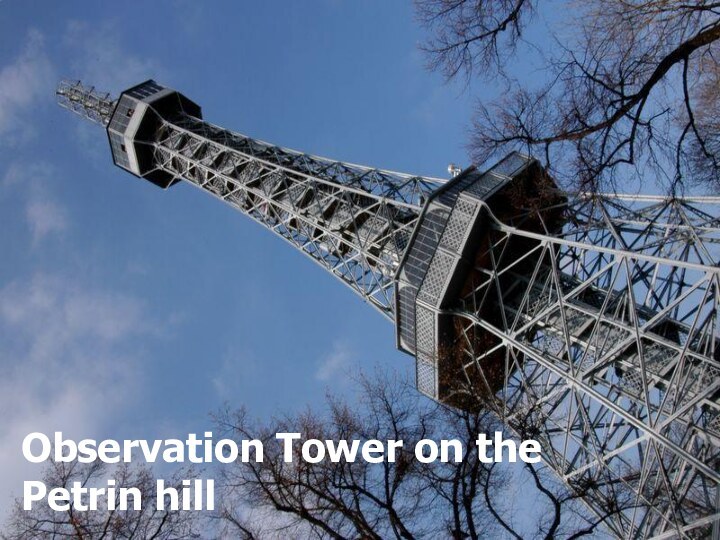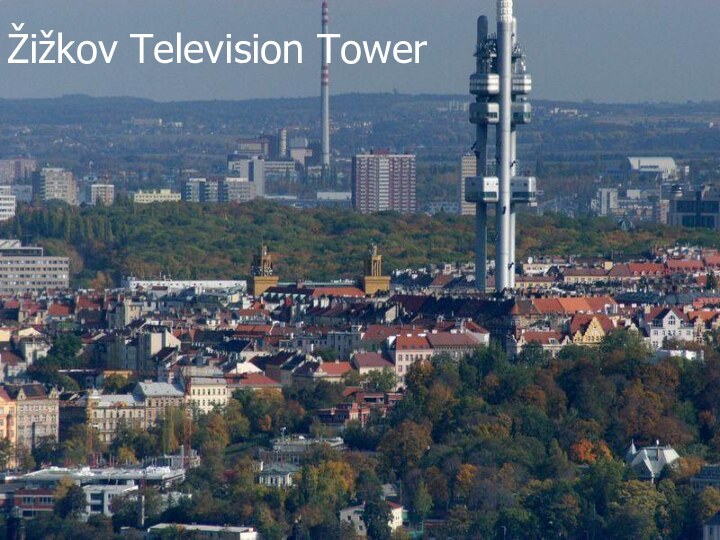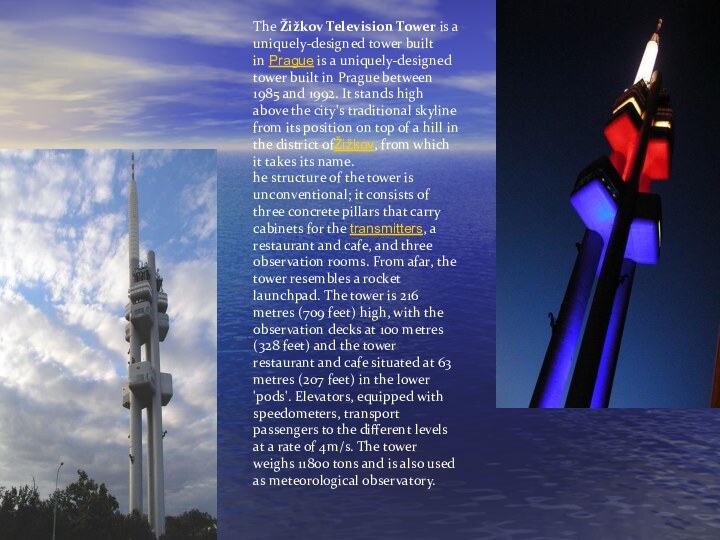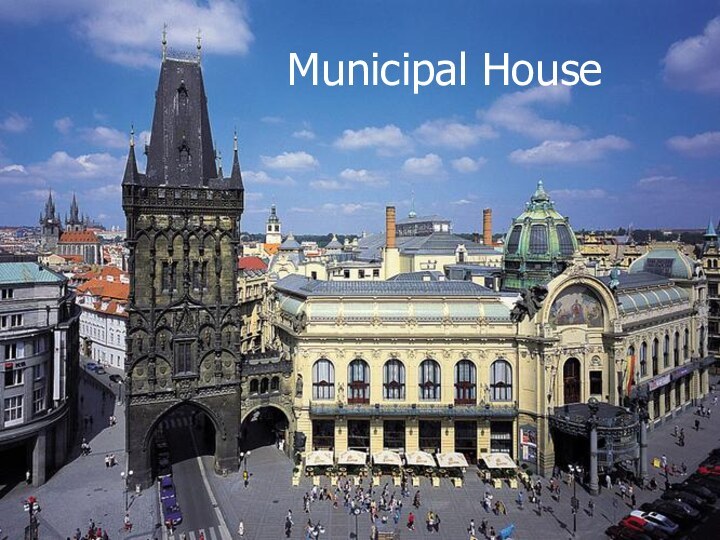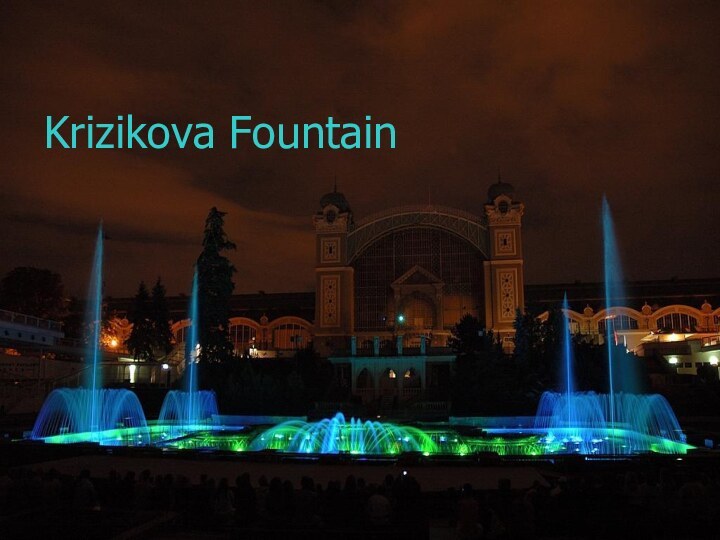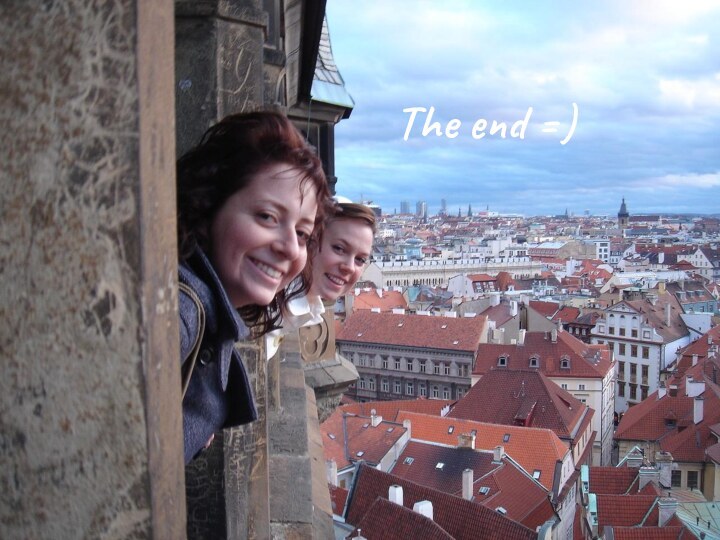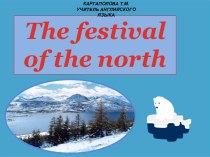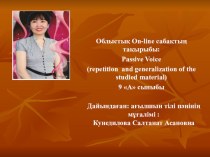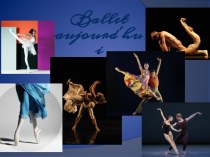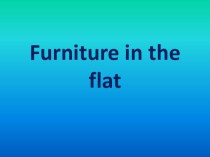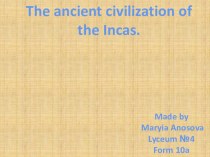Слайд 2
Prague, also known as Zlata Praha in the
past, is the capital and largest city of the
Czech Republic. Situated on the bank of River Vltava in central Bohemia, the beautiful city of Prague is rich in history and lies in the heart of Europe.
Prague’s history goes into great depth and the city is renowned for having the largest ancient castle in the world, according to the Guinness World Records. Prague Castle rests amongst other countless cultural treasures in Prague’s possession, attracting millions of tourists every year.
Official Name: Hlavní město Praha
Nickname: Golden City, City of a hundred spires
Слайд 4
Prague Castle is the biggest ancient castle
in the world, being 570 meters in length and
about 130 metres wide and was erected in the 9th century. It was replaced by a Romanesque palace in the 12th century and then in the 14th century was rebuilt in the Gothic style under the ruling of Charles IV. At the end of 15th century, a reconstruction of the palace took place under the Jagellons, the Vladislav Hall was further added by Benedikt Rejt. The Castle had to undergo further works in the 16th century.
Today it serves as the historical and political centre for the city and the state, and it is also the place of the President of the Czech Republic. For the visitors, Prague Castle is a "must see". The Saint Vitus Cathedral, the Monastery, Golden Lane, St. George's Basilica and several other places along with the viewing towers and art galaries can be discovered by taking a walking tour of the Prague Castle.
Слайд 6
This is is mounted on the
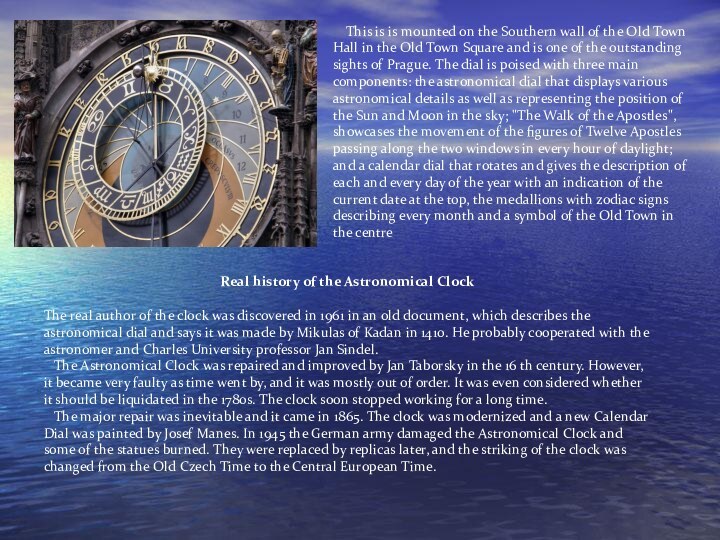
Southern wall of the Old Town Hall in the
Old Town Square and is one of the outstanding sights of Prague. The dial is poised with three main components: the astronomical dial that displays various astronomical details as well as representing the position of the Sun and Moon in the sky; "The Walk of the Apostles", showcases the movement of the figures of Twelve Apostles passing along the two windows in every hour of daylight; and a calendar dial that rotates and gives the description of each and every day of the year with an indication of the current date at the top, the medallions with zodiac signs describing every month and a symbol of the Old Town in the centre
Real history of the Astronomical Clock
The real author of the clock was discovered in 1961 in an old document, which describes the astronomical dial and says it was made by Mikulas of Kadan in 1410. He probably cooperated with the astronomer and Charles University professor Jan Sindel.
The Astronomical Clock was repaired and improved by Jan Taborsky in the 16 th century. However, it became very faulty as time went by, and it was mostly out of order. It was even considered whether it should be liquidated in the 1780s. The clock soon stopped working for a long time.
The major repair was inevitable and it came in 1865. The clock was modernized and a new Calendar Dial was painted by Josef Manes. In 1945 the German army damaged the Astronomical Clock and some of the statues burned. They were replaced by replicas later, and the striking of the clock was changed from the Old Czech Time to the Central European Time.
Слайд 8
The Charles Bridge over the
river Vltava is definitely one of the most beautiful
places in Prague. It is the oldest bridge in the city, built between the 14 th and 15 th century, and it spans the river with 16 pillars. It is lined with statues and lamps and this scenery together with the Gothic bridge towers on both ends makes the Charles Bridge a breathtaking historical monument. There is no better place in Prague for a walk in the evening.
Слайд 10
One of the biggest Museums in
Prague, the National Museum is one of the main
tourist attractions. Originated in 1818 in Prague by Kašpar Maria Šternberg, the museum has around 14 million items varying from natural history, arts and music. Entry to the Museum is free every first Monday of the month and the museum is closed every first Tuesday of the month.
The National Museum has five main departments: the scientific museum, the historical museum, the museum of Asian, African and American culture, the museum of Czech music and the Library of the National Museum with the Book Museum exhibition. Apart from the main building of the National Museum, you can see its collections in various buildings around Prague, such as the Exhibition Area in Holesovice, and also outside Prague.
Слайд 11
Observation Tower on the
Petrin
hill
Слайд 12
While in Prague, you will spot
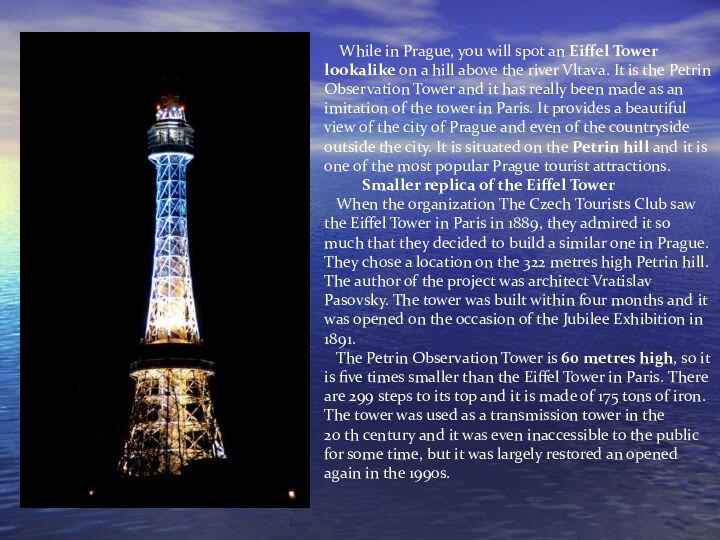
an Eiffel Tower lookalike on a hill above the river Vltava.
It is the Petrin Observation Tower and it has really been made as an imitation of the tower in Paris. It provides a beautiful view of the city of Prague and even of the countryside outside the city. It is situated on the Petrin hill and it is one of the most popular Prague tourist attractions.
Smaller replica of the Eiffel Tower
When the organization The Czech Tourists Club saw the Eiffel Tower in Paris in 1889, they admired it so much that they decided to build a similar one in Prague. They chose a location on the 322 metres high Petrin hill. The author of the project was architect Vratislav Pasovsky. The tower was built within four months and it was opened on the occasion of the Jubilee Exhibition in 1891.
The Petrin Observation Tower is 60 metres high, so it is five times smaller than the Eiffel Tower in Paris. There are 299 steps to its top and it is made of 175 tons of iron.
The tower was used as a transmission tower in the 20 th century and it was even inaccessible to the public for some time, but it was largely restored an opened again in the 1990s.
Слайд 14
The Žižkov Television Tower is a uniquely-designed tower built in Prague is
a uniquely-designed tower built in Prague between 1985 and 1992. It
stands high above the city's traditional skyline from its position on top of a hill in the district ofŽižkov, from which it takes its name.
he structure of the tower is unconventional; it consists of three concrete pillars that carry cabinets for the transmitters, a restaurant and cafe, and three observation rooms. From afar, the tower resembles a rocket launchpad. The tower is 216 metres (709 feet) high, with the observation decks at 100 metres (328 feet) and the tower restaurant and cafe situated at 63 metres (207 feet) in the lower 'pods'. Elevators, equipped with speedometers, transport passengers to the different levels at a rate of 4m/s. The tower weighs 11800 tons and is also used as meteorological observatory.
Слайд 16
The Municipal House is known mainly for its Concert
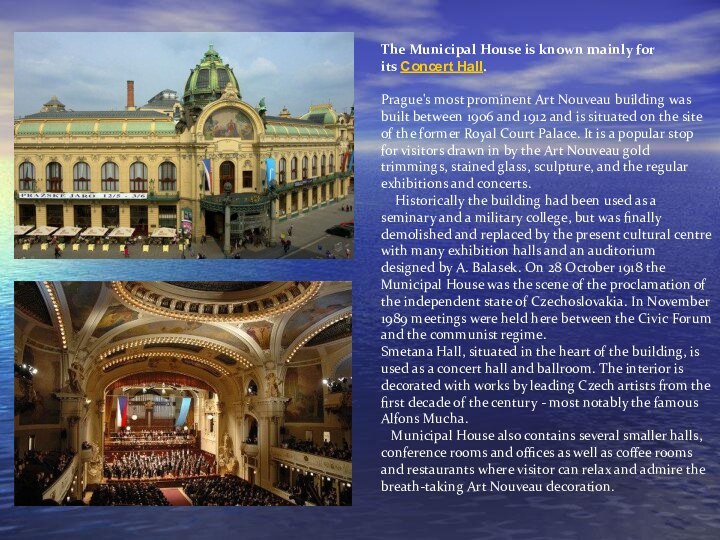
Hall.
Prague's most prominent Art Nouveau building was built between
1906 and 1912 and is situated on the site of the former Royal Court Palace. It is a popular stop for visitors drawn in by the Art Nouveau gold trimmings, stained glass, sculpture, and the regular exhibitions and concerts.
Historically the building had been used as a seminary and a military college, but was finally demolished and replaced by the present cultural centre with many exhibition halls and an auditorium designed by A. Balasek. On 28 October 1918 the Municipal House was the scene of the proclamation of the independent state of Czechoslovakia. In November 1989 meetings were held here between the Civic Forum and the communist regime.
Smetana Hall, situated in the heart of the building, is used as a concert hall and ballroom. The interior is decorated with works by leading Czech artists from the first decade of the century - most notably the famous Alfons Mucha.
Municipal House also contains several smaller halls, conference rooms and offices as well as coffee rooms and restaurants where visitor can relax and admire the breath-taking Art Nouveau decoration.
Слайд 18
Krizik Fountain attracts large groups of
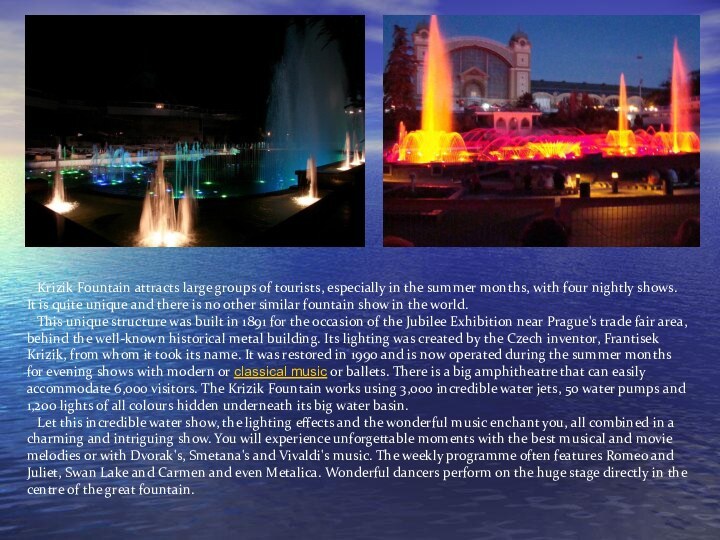
tourists, especially in the summer months, with four nightly
shows. It is quite unique and there is no other similar fountain show in the world.
This unique structure was built in 1891 for the occasion of the Jubilee Exhibition near Prague's trade fair area, behind the well-known historical metal building. Its lighting was created by the Czech inventor, Frantisek Krizik, from whom it took its name. It was restored in 1990 and is now operated during the summer months for evening shows with modern or classical music or ballets. There is a big amphitheatre that can easily accommodate 6,000 visitors. The Krizik Fountain works using 3,000 incredible water jets, 50 water pumps and 1,200 lights of all colours hidden underneath its big water basin.
Let this incredible water show, the lighting effects and the wonderful music enchant you, all combined in a charming and intriguing show. You will experience unforgettable moments with the best musical and movie melodies or with Dvorak's, Smetana's and Vivaldi's music. The weekly programme often features Romeo and Juliet, Swan Lake and Carmen and even Metalica. Wonderful dancers perform on the huge stage directly in the centre of the great fountain.
